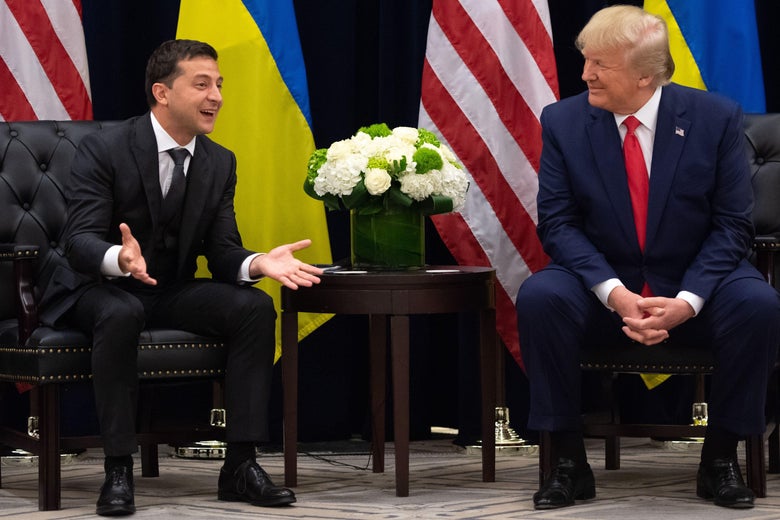
President Trump and Ukrainian President Volodymyr Zelensky meet in New York on September 25, 2019, on the sidelines of the United Nations General Assembly.
SAUL LOEB/Getty Images
It was the Washington Post and New York Times’ reporting on the whistleblower complaint about Trump’s call with the Ukrainian president that prompted the White House to release an approximate transcript of the call and, in turn, Democrats in Congress to launch a formal impeachment inquiry. The seriousness of the situation accelerated events—and the story—past whistleblower’s account of the initial July call between Trump and President Volodymyr Zelensky of Ukraine, but the contents of what the whistleblower saw and heard, and what the intelligence community inspector general discovered in response to the complaint, could provide vital context for the call, how the White House viewed it at the time, and what happens next.
After initially trying to suppress the complaint, the Trump administration is reportedly set to release it, potentially as early as Thursday. Congressional leaders and members of the intelligence committees were allowed review the complaint, which is still classified, Wednesday night. Until we have text of the real thing, here’s what we know from the reporting so far about what’s in the complaint and what it means.
• The intelligence officer who filed the complaint did so not only because the official was concerned about what transpired on the call, but, according to the New York Times, was also alarmed by the unusual way the White House handled the internal record of the conversation. The Washington Post reports that at some point the White House moved records of Trump’s communications with foreign officials from where they are normally kept onto a separate computer network.
• The whistleblower was not, however, personally on the July 25call, nor did the complainant have access to the readout of the call before coming forward, according to the inspector general for the intelligence community, Michael Atkinson.
• The whistleblower instead was made aware of the call by White House officials expressing concern that Trump, according to a Justice Department memo, “abused his authority or acted unlawfully in connection with foreign diplomacy.”
• In the complaint, the whistleblower said there were multiple White House officials that were witness to the call and could corroborate the allegations.
• The inspector general, a Trump appointee who elevated the complaint, interviewed these witnesses.
• The inspector general concluded from his fact-finding that President Trump had potentially broken the law by soliciting what amounted to a foreign campaign contribution, which exposed the president “to serious national security and counterintelligence risks.”
Of all of the new data points on the whistleblower complaint, now that the White House’s version of the transcript is out in the open, the most intriguing bit of information is the whistleblower’s apparent concern about how the Trump administration was characterizing and memorializing the contents of the call. Were portions of the call intentionally omitted from the record? Or distorted? That will be an important line of inquiry when the full complaint is released.
from Slate Magazine https://ift.tt/2nt0Cnh
via IFTTT
沒有留言:
張貼留言